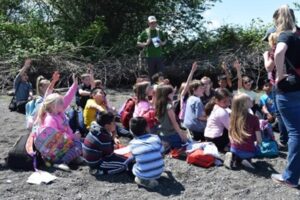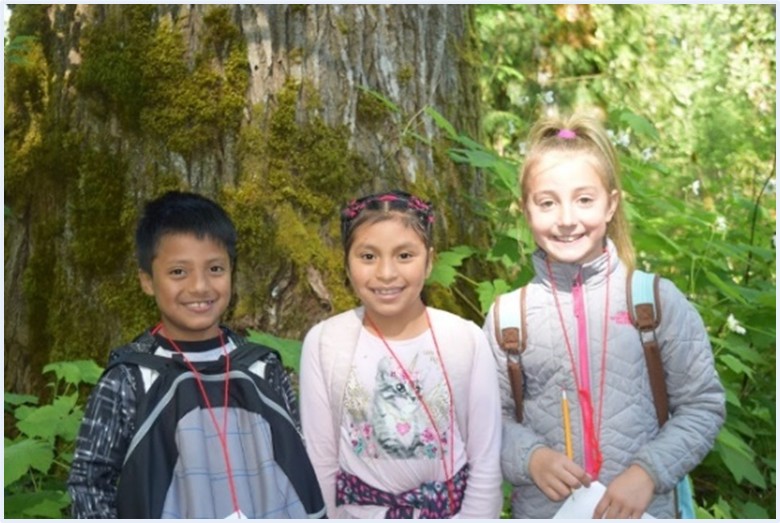From early morning to late afternoon over a two-week period, over 20 volunteers gather at Capitol Land Trust’s Bayshore Preserve to set up twelve education stations. Their goal: to introduce every seventh grader at Shelton’s Oakland Bay Middle School to the preserve’s 74 acres of shoreline, restored salmon habitat, and saltwater marshes. It’s a remarkable feat, made possible by a team of community organizations brought together by the Pacific Education Institute (PEI) to support the Shelton School District.
“There’s no way we could do our work without community partners,” says Ariel Wahoub, Education Coordinator for Puget Sound Estuarium, “especially with these larger-scale projects.” In this case, Capitol Land Trust supplies the site and the Mason Conservation District offers AmeriCorps volunteers and education staff to support the Estuarium in running the twelve education stations, with PEI ensuring that all curriculum meets Next Generation Science Standards (NGSS).
Such partnerships are a key component of FieldSTEM, PEI’s educational model that provides professional development for K-12 teachers focused on outdoor-based STEM rooted in local natural resources. PEI works with individual teachers, schools and entire districts to integrate locally relevant STEM across subject areas and grade levels. While teachers and students are the most obvious beneficiaries of this approach, community partners benefit as well.
“It lessens our burden to collaborate with an educational organization that knows about working with kids around different topics,” says Mary Birchem, Outreach and Environmental Educator at Capitol Land Trust. “We know everything there is to know about conservation, but as an organization, we may not know exactly how to work with kids. By partnering with PEI and other groups, we’re able to improve the quality of the program because they’re the experts.”
Collaboration also allows groups to share resources, she notes. “The Land Trust might have a book on how to define this plant, but we might not have marine animal ID cards,” she says. “On the other side, educational organizations don’t typically have the opportunity to have preserves open for them. Together, we develop infrastructure to support on-the-land learning.”
marine animal ID cards,” she says. “On the other side, educational organizations don’t typically have the opportunity to have preserves open for them. Together, we develop infrastructure to support on-the-land learning.”
PEI also helps organizations to connect, according to Jen Thurman-Williams, Environmental Specialist at Mason Conservation District. “For us, it’s been great to be able to build stronger relationships with business agencies and community members,” she says. The nonprofit has brought 5th-grade students out to Cranberry Lake Forest Education & Research Center to conduct a PEI forest benefits experience and connected 3rd graders with a local shellfish company during their field experience.
Increasingly, foundations and corporate groups that fund nonprofit organizations prefer those that are engaged in such collaborations, according to Aimee Christy, a Research Biologist with the Pacific Shellfish Institute. “From a grant writing perspective, there is always much more power in collaborating with people,” she explains. “The work we do with PEI is directly in line with our mission and vision statement. We’re looking to provide science-based, hands-on learning related to shellfish, water quality, and stewardship. We want kids that are knowledgeable and inspired to take everyday action to protect Puget Sound.”
In a similar vein, working with PEI helps the Puget Sound Estuarium to deliver its mission. Wahoub has noticed that both teachers and students from classes that are implementing FieldSTEM are much more engaged during events like the trip to the Bayshore Preserve.
“It makes all the difference in the world,” she says. “The teachers are more ready to prep the kids to do pre-learning and post-learning. It seems to be a more well-rounded curriculum, rather than just, ‘We’re going to interrupt what we’re doing at school to go out, have a break, and come back.’ That makes my time as an educator worth it, instead of teaching to a bunch of people who don’t want to be there or don’t understand why they’re there.”
By now, groups like the Estuarium and Pacific Shellfish Institute have been working with students and teachers via PEI for years. Those interactions have changed over time, according to PSI’s Christy. “We meet with teachers and make sure the programs are meeting their needs,” she says. “We tweak them as necessary, and then the students seem really well-prepared because everything has been building on itself from year to year.”
One final benefit for all of the partner organizations is the potential for a home-grown workforce, either paid or volunteer, with a deep understanding of both regional ecosystems and the industries that depend on them. “Students can see that they don’t have to leave their community to get a great job,” says Thurman Williams of the Mason Conservation District. “We have a shellfish program and a forestry program where we go to the estuaries. It allows them to understand that there are opportunities for them to have well-paying jobs where they can be outside.”
